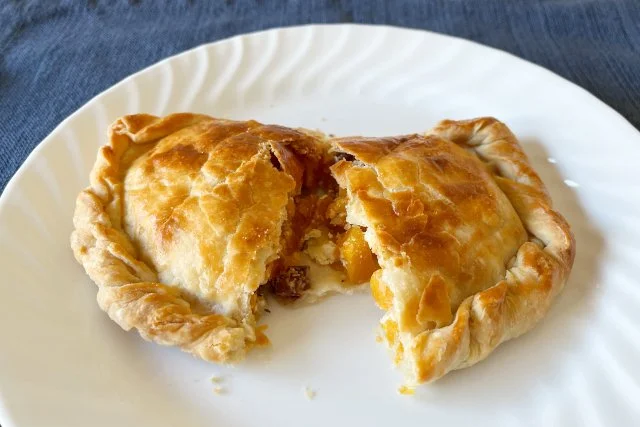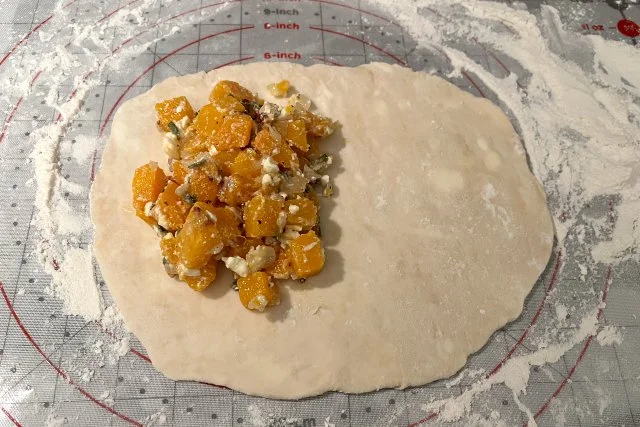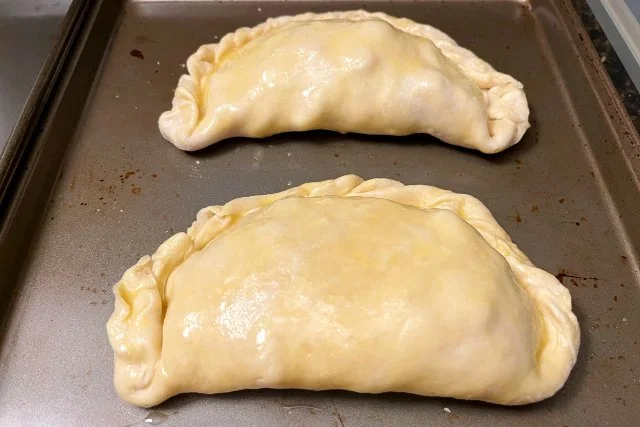Butternut Squash Cornish Pasties Adventure
My cooking mojo felt off for a while. Then I realized it wasn’t a dearth of inspiration or motivation or interesting ingredients, but stress from major issues with our house. Moving proved wrenching yet necessary.
As we unpacked and relied on takeout from various specialty eateries in the new neighborhood, a return to culinary adventures started to seem realistic. Just in time for the holidays, too.
Our generous Thanksgiving host in the South Bay requested roasted root vegetables, which reminded me about a thwarted plan to make vegetarian pasties earlier this year.
The green grocer that used to be walking distance is now a dedicated drive, but worth the effort. That’s where I discovered decent McIntosh apples — in California. It’s also where I unearthed the sweetest, freshest butternut squash we’d ever tasted. By the time the pasty idea came up last spring, the squash were long gone. Now, thankfully, the bins are full again.
Before all this, I’d only read about pasties in British novels and seen them on TV. Traditionally, a Cornish pasty is a D-shaped crimped pastry containing beef, potato, turnip, onion, plus some salt and pepper seasoning, according to the Cornish Pasty Association. The association’s strict rules say to let the veggies steam inside as they bake, but there’s little tradition in my plan. After experimenting with roasted butternut squash in homemade ravioli, I envisioned similarly satisfying savory hand pies.
Inspiration came from several recipes. Food columnists Henry Dimbleby and Jane Baxter, writing for the Guardian a while back, proposed “a punk pasty to peeve the purists” featuring roasted squash and red onion, blue cheese, spinach, and American pecans with a crimped top (gasp). Emily Han’s recipe for the Kitchn went another way, placing uncooked squash, red onion, garlic, sage, and parsley with Parmesan and toasted pine nuts inside the dough to bake. Although highly-rated pasty dough recipes abound, I avoided any that called for lard to keep this vegetarian.
For a recipe cobbled together from numerous and sometimes conflicting sources, my first pasties turned out pretty well. They needed some tweaks, though. The onion wasn’t cooked enough, the dough lacked salt, the fresh sage got lost, and the pasties were missing an acid to help cut through all the fat.
Second time around, everything went a lot more smoothly except the dough, which got too wet and didn’t end up being as flaky as the first pass. But the onion cooked through, the extra sage tasted good, and the lemon juice lifted everything.
This recipe was fairly forgiving. Even after accidentally leaving the squash mixture in the oven too long, it was still delicious. My crimping technique needs honing, but none of the pasties came apart or exploded. The best things really do come in small packages.
Roasted Butternut Squash and Feta Pasties
Filling:
1 butternut squash weighing approx. 2 – 3 lbs.
1 sweet onion
4 whole garlic cloves or 2 if they’re large
4 oz. feta cheese
¼ C. chopped pecans
3 Tbsp. olive oil
12 fresh sage leaves
Salt
Black pepper, freshly ground
2 Tbsp. fresh lemon juice
Dough:
450g (3½ C.) all-purpose flour, plus extra for assembly
1½ tsp. salt
½ C. unsalted butter, cold
½ C. shortening
Approx. ¾ to 1 C. cold water
Several ice cubes
1 large egg, for assembly
Equipment: Baking sheets, pastry cutter, rolling pin, silicone brush.
Sift the flour into a large mixing bowl. Stir in the salt with a fork. Measure out the shortening. Dice the cold butter. Measure out the cold water, adding a couple ice cubes to keep it very cold.
Using a pastry cutter, mix the butter and shortening into the flour until the dough looks like coarse crumbs.
Slowly add cold water a tablespoon or two time, mixing with a wooden spoon until just combined and the dough holds its shape. Avoid over-wetting, over-handling, or over-mixing. Shape the dough into a ball, wrap in plastic, and refrigerate for 30 minutes minimum. Okay to keep it refrigerated for longer.
Preheat oven to 400°F.
Peel, trim, and finely dice the onion. Add to a large mixing bowl. Trim, peel, and remove the seeds from the butternut squash. Cut it into chunks around ¾-inch in size and place them into the same mixing bowl. Peel and trim the whole garlic cloves, cutting them in half if they’re large, and put them in.
Toss the veggies with around 3 – 4 tablespoons olive oil and season generously with table salt and freshly ground black pepper.
Spread the mixture evenly on a large baking pan and roast for 25 – 35 minutes, or until squash is just tender and garlic roasted. Take the pan out of the oven. Turn the oven off.
Remove the roasted garlic to a cutting board, mince it, and set aside.
Allow the squash mixture to cool completely before moving onto the next step so the pastry dough doesn’t melt.
Transfer the cooled filling mixture to a clean bowl. Mix in the minced roasted garlic. Mince the sage and add to the squash. Stir in 2 Tbsp. lemon juice. Crumble the feta cheese, finely chop the pecans, and stir them in. Taste the filling and adjust the seasoning if needed until it tastes delicious. Set aside.
Crack the egg into a small bowl and whisk with a fork for the wash.
Preheat the oven to 400°F again.
On a clean floured surface, gently roll the dough into a log and cut it into 6 equal pieces. Set them on a clean plate.
Going one at a time, use a floured surface and floured rolling pin to roll a dough piece out until it’s a circle around 8 inches or so in diameter.
Place one sixth of the filling into one half the circle, leaving about ½-inch uncovered around the edge for crimping. Brush a small amount of egg wash along that edge, fold the uncovered dough half over the filling, press the edges together, and crimp the edges to seal it using whatever method works best for you. How-to pasty crimping videos abound.
Repeat with the rest of the dough and filling. Do not prick the pasties; the filling is already fully cooked so there’s minimal steam.
Place the large pasties on two baking sheets and carefully brush the tops with the rest of the egg wash. Bake for 35 to 40 minutes or until they have a nice golden color, swapping the baking sheets halfway through if they don’t both fit on the center rack. Allow to cool slightly before eating.
Leftovers: Wrap each pasty individually in aluminum foil and refrigerate. They should keep for several days. Preheat oven to 225°F. Unwrap a pasty from the foil and set in the oven either uncovered on the foil sheet or on a baking sheet. Reheat for around 25 minutes or until warmed through and crispy on the outside. Let cool slightly again before eating.




